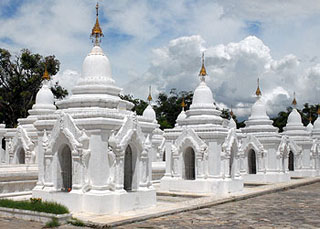Kuthodaw Pagoda is located at the base of the southeast stairways to Mandalay Hill.
The World’s Largest Book The Kuthodaw Pagoda or Maha Lawka Marazein Paya is often called the world’s largest book. It is a large walled complex situated at the base of the southeast stairway to Mandalay Hill and was built by King Mindon at the same time he was constructing the Royal Palace. Its central stupa is modeled on the Shwezigon at Nyaung U near Bagan.


The Kuthodaw Paya (Pagoda), or Maha Lawka Marazein Paya, contains what often is called the world’s largest book. It is a large walled complex situated at the base of the southeast stairway to Mandalay Hill and was built by King Mindon at the same time he was constructing the Royal Palace. Its central stupa is modeled on the Shwezigon at Nyaung U near Bagan. An on-site carved tablet indicates that the pagoda’s height is 187 ft 9 in, high, while some guide books list it at 100 ft (30 m). The former includes the platform in the measurement.
STRUCTURE
The stupa itself, connected to the outside entry by means of a long corridor, is set in the middle of a thirteen acre field of 729 pitaka pagodas or shrines (Dama Cetis). Each shrine contains a marble slab, inscribed on both sides with the Pali script text of a portion the Tipitaka (Pali spelling, or Tripitaka, in Sanskrit), Theravada Buddhism’s sacred texts. Taken together, they contain the entire text of the Tipitaka and thus form “the world’s largest book.” The slabs were carved from white Sagyin Hill marble found just a few miles north of Mandalay. The work of carving began in October 1860 and was carried out in a special hall within King Mindon’s Royal Palace. Each slab is 5 ft ((1.5 m) by 3.5 ft (1.1 m) wide and 5-6 in. (12.7 – 15 cm) thick. The Buddhist scholar/carvers completed their task in May 1869. If spread out horizontally, the slabs would cover a third of an acre (.1 ha); stacked vertically, the ‘pages’ would rise 340 ft (103 m). Originally the lettering also had a gold leaf veneer. The statistics given here are those given by U Tun Aung Chain, retired Professor of History, Yangon University.


Several sources suggest the important role of the Fifth Buddhist Synod, which King Mindon called in 1872, in the development of the Kuthodaw. It perhaps was at this meeting of 2,400 monks from throughout the country that both authenticated the texts and began the construction of the encasing shrines.
TRAVEL TIPS
Entrance Fee – US$5 per person.
Nearby Attraction
KYAUKTAWGYI PAGODA
Kyauktawgyi Pagoda, the pagoda of the “Great Marble Image,” is sited near the southern entry to Mandalay Hill. Although its construction was started in 1853 by King Mindon, it was not completed until 1878, in part due to a palace rebellion and domestic disturbances in the mid-1860s. The chief feature of the Kyauktawgyi Paya is huge seated Buddha figure sculpted from a single block of pale green marble from the Sagyin quarry twelve miles north of Mandalay.
